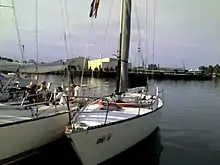Tartan Ten
The Tartan Ten, also called the Tartan 10, is an American sailboat that was designed by Sparkman & Stephens as a one-design racer and first built in 1978.[1][2][3]
Class symbol | |
 | |
| Development | |
|---|---|
| Designer | Sparkman & Stephens |
| Location | United States |
| Year | 1978 |
| No. built | 400 |
| Design | One-design |
| Builder(s) | Tartan Marine |
| Boat | |
| Boat weight | 7,100 lb (3,221 kg) |
| Draft | 5.83 ft (1.78 m) |
| Hull | |
| Type | Monohull |
| Construction | Fiberglass |
| LOA | 33.15 ft (10.10 m) |
| LWL | 27.00 ft (8.23 m) |
| Beam | 9.25 ft (2.82 m) |
| Engine type | Farryman 9 hp (7 kW) diesel engine |
| Hull appendages | |
| Keel/board type | fin keel |
| Ballast | 3,340 lb (1,515 kg) |
| Rudder(s) | internally-mounted spade-type rudder |
| Rig | |
| Rig type | Bermuda rig |
| I (foretriangle height) | 35.00 ft (10.67 m) |
| J (foretriangle base) | 12.00 ft (3.66 m) |
| P (mainsail luff) | 40.25 ft (12.27 m) |
| E (mainsail foot) | 13.75 ft (4.19 m) |
| Sails | |
| Sailplan | Masthead sloop |
| Mainsail area | 276.72 sq ft (25.708 m2) |
| Jib/genoa area | 210.00 sq ft (19.510 m2) |
| Total sail area | 486.72 sq ft (45.218 m2) |
| Racing | |
| PHRF | 126 (average) |
The Tartan Ten design was developed into the LS-10 in the early 2000s.[4]
Production
The design was built by Tartan Marine in the United States. The company produced 400 examples of the type between 1978 and 1988, but it is now out of production.[1][3][4]
Design

The Tartan Ten is a recreational keelboat, built predominantly of fiberglass, with aluminum spars. It has a 7/8 fractional sloop rig, a raked stem, a reverse transom, an internally mounted spade-type rudder controlled by a tiller and a fixed fin keel. It displaces 7,100 lb (3,221 kg) and carries 3,340 lb (1,515 kg) of ballast.[1][3]
The boat has a draft of 5.83 ft (1.78 m) with the standard keel fitted.[1]
The boat is fitted with a Farryman 9 hp (7 kW) diesel engine for docking and maneuvering. The fuel tank holds 12 U.S. gallons (45 L; 10.0 imp gal) and the fresh water tank has a capacity of 19 U.S. gallons (72 L; 16 imp gal).[1][3]
Being intended for racing, the design has a flush deck and very little interior space. There are six berths, including a bow "V"-berth, which has the head underneath and a privacy curtain. The galley is located amidships and includes a manual pump sink and a portable ice box. The chart table doubles as a galley table.[3]
The halyards are all internally-mounted, as is the reefing system and the 4:1 outhaul. The mast can be shaped by the shrouds and 4:1 mechanical advantage backstay. There are two jib sheet winches in the cockpit and two halyard winches on the cabin top. The boom vang has a 4:1 mechanical advantage and can also be employed as a preventer, when attached to the rail. A genoa track system was a factory option.[3]
Lacking any cabin windows, ventilation is provided by a large deck hatch on the foredeck, which is also used to pass sails below for storage.[3]
Variants
- Tartan Ten
- Initial model introduced in 1978.[1]
.jpg.webp)
- LS-10
- Southern Caribbean (SOCA) Sailboats produced an updated version of the Tartan Ten from the early-2000s until mid-2010s called the LS-10. It was built using the original hull molds and designed to conform to the Tartan Ten class rules for one-design racing, but with improved comfort, functionality and layout.[4][5][6]
Operational history
In a 1992 review Richard Sherwood noted, "while the Tartan Ten was not designed to any rule, she was designed primarily for racing. The flush deck leaves little room in the cabin; and while there are six berths, the general cabin appointments are for weekends and overnights, not extended cruising. The Ten is a one-design and is delivered complete. No hull or rig alterations are allowed."[3]
The Tartan Ten was inducted into the American Sailboat Hall of Fame in 1998. The citation, written by Josh Adams of Sail Magazine, noted, "Tartan Marine’s effect on the racing community with the T10 went beyond the boat. Now Sailors could forget about their boat’s rating and compete boat for boat. Inshore, Tartan’s energized approach to fleet development, spawned large fleets throughout the Midwest. The all purpose mission of the Tartan Ten: ready for offshore, good around the buoys, and fun for the small-family cruise or daysail."[7]
See also
Similar sailboats
References
- McArthur, Bruce (2019). "Tartan 10 sailboat". sailboatdata.com. Archived from the original on 18 October 2018. Retrieved 13 December 2019.
- McArthur, Bruce (2019). "Sparkman & Stephens". sailboatdata.com. Archived from the original on 31 March 2019. Retrieved 13 December 2019.
- Sherwood, Richard M.: A Field Guide to Sailboats of North America, Second Edition, pages 262-263. Houghton Mifflin Company, 1994. ISBN 0-395-65239-1
- Kretschmer, John (10 November 2008). "LS-10". Sailing Magazine. Archived from the original on 12 September 2017. Retrieved 12 September 2017.
- "LS10". Archived from the original on 24 November 2005. Retrieved 12 September 2017.
- "2001 Soca Boats LS-10 / T-10". Boat Trader. Archived from the original on 20 April 2018. Retrieved 12 September 2017.
- Adams, Josh (1998). "Tartan Ten". American Sailboat Hall of Fame. Archived from the original on 28 January 2007. Retrieved 13 December 2019.
External links
 Media related to Tartan Ten at Wikimedia Commons
Media related to Tartan Ten at Wikimedia Commons